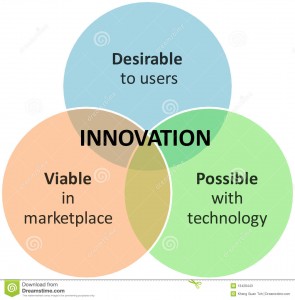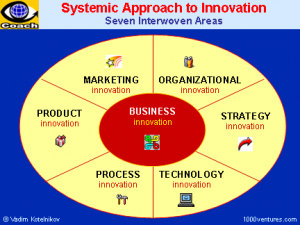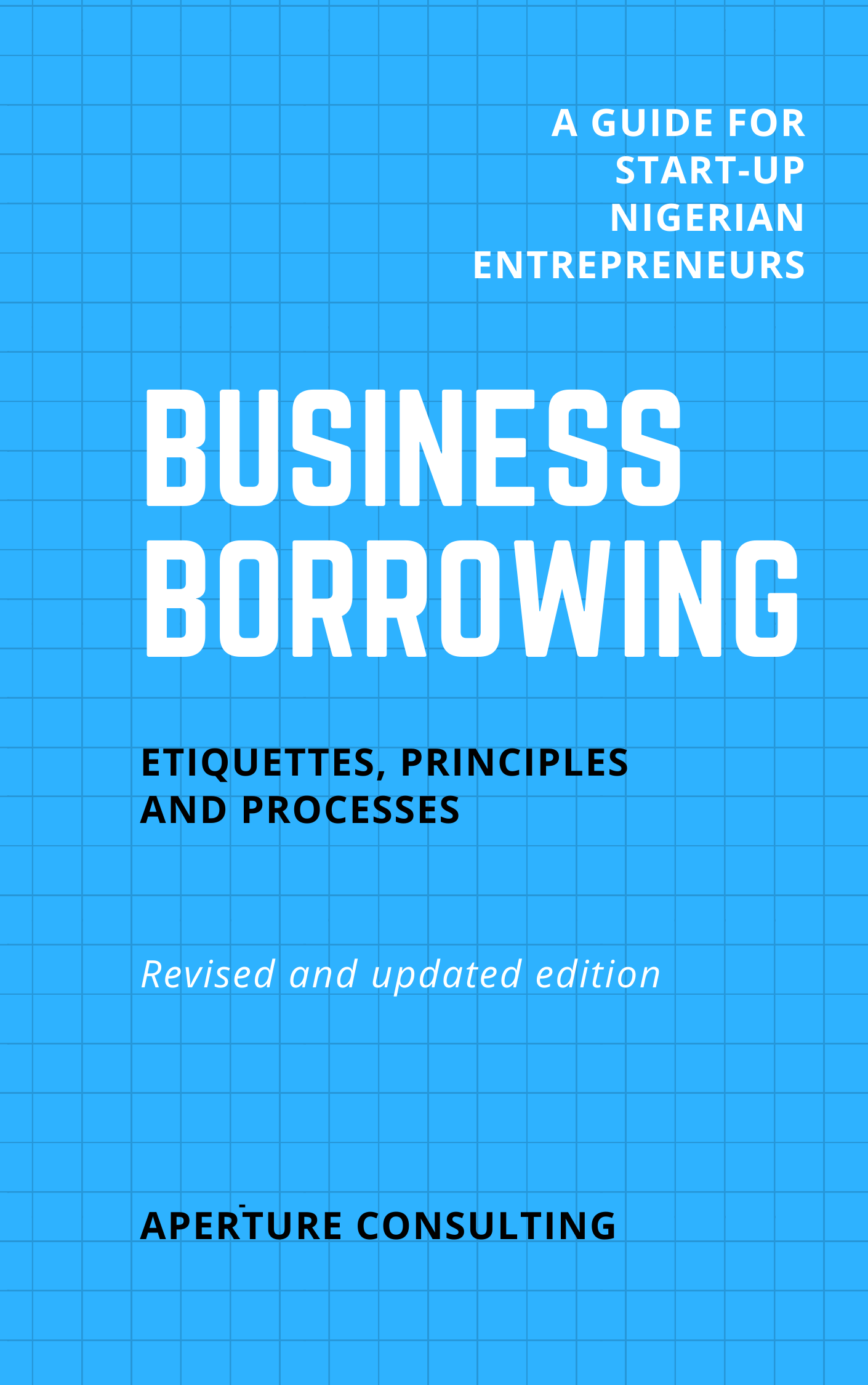Innovation: The Conference Board of Canada defines innovation as ‘the process through which economic and social value is extracted from knowledge through the generation, development, and implementation of ideas to produce new or improved strategies, capabilities, products, services, or processes’.
Ron Jonash, of Monitor Group however has this to say on innovation: ‘I have found it most helpful to define “business innovation” (as distinct from general innovation) as the “creation and capture of new value in new ways.” This definition has made innovation more actionable and measurable in business terms and makes it inclusive of “new” offerings and value propositions (new services or products), “new” methods (new technology applications or business processes), and “new” business models (new channels, partners and financial models for capturing value from innovation investments.’
Simply put, business innovation refers to the process of generating and implementing ideas which continuously improve products (and services) and methodologies as well as discover new markets. Ultimately innovation should add value and enhance your competitive position.
Though used almost interchangeably, it important to establish the difference between innovation and creativity from this onset. Creativity in an individual or group refers to the ability to come up with new ideas. It is about harnessing the power of our minds to conceive new ideas, products, and/or processes. Innovation on the other hand refers to the capability to act on these ideas, thereby transforming them into possible beneficial results. It is about taking newly generated ideas and developing them into useful products, services and methodologies.
 Benefits of innovation: Innovation is critical to the growth and success of your enterprise. It will make it possible for your business to be very efficient; it will improve the quality of your products; it will help you attract and retain the best business hands in your industry.
Benefits of innovation: Innovation is critical to the growth and success of your enterprise. It will make it possible for your business to be very efficient; it will improve the quality of your products; it will help you attract and retain the best business hands in your industry.
Your capacity to innovate will not only make it possible for you to serve your existing customers, but will also make it possible for you to predict trends and seize emerging (evident and not-so-evident) opportunities. It is therefore your ability to innovate that will keep you ahead as markets, trends and technologies shift.
All functional units of your business, such as finance, human resource, sales and marketing, R & D, etc. will also improve from an entrenched culture of innovation. It will improve your profitability and long term viability of your business by keeping you ahead of the competition.
Types of innovations: There are two types and many levels of innovations. Some innovations can be ‘radical’ whilst others can be ‘incremental’. No matter their type and depth though, the important thing is that they bring a positive outcome. An innovation is considered ‘radical’ if it gives raise to a completely new product or disrupts existing process of production or service delivery. Typically, radical innovations result from research and keen eyes that see beyond existing demands and trends. Examples of radical product innovations include the iPad, Polaroid Camera, and Penicillin. Radical service innovations include Online Shopping and the Internet. Radical Innovation in process include the assembly line production system of automobiles, lean manufacturing, etc. Entrepreneurs that fall into these category include Henry Ford and Steve Jobs. Organisations that fall into these category are Apple and Zappos.
On the other hand, an innovation is said to be ‘incremental’ if it offers marginal improvements on existing products, services and processes. Incremental innovation in products are for instance the iPad mini (which came as second generation after the initial and first launch of the iPad). Incremental change in service are for instance same day dry cleaning whilst an example of incremental process is a reduction of the number of steps in an automated production line.
To lead your company effectively through innovation and business development, you will need to develop a structured and analytical approach to issues. Each innovative idea has various aspects that must be understood. Some aspects will refer to the value proposition of the idea; some to its future users; some to probable responses from competition, etc. An innovation does not therefore become successful by taking a one-sided focus on any one of these aspects. You will have to understand the processes of identifying ideas for innovation, strategies in different types of companies and markets, as well as how innovation should be incorporated as a key and integral component of the overall strategy of your company.
Know thyself: There are three types of innovators viz: Adopters, Industry Leaders, and Global Leaders. As the name suggests, adopters do not originate innovations. They rather ‘adopt’ what has been invented. Industry leaders however adopt ahead of other firms in their industry. On the extreme end of the spectrum, global leaders typically originate innovations.
Now, this is by no means is clear cut. As happens frequently, entrepreneurial firms (from the so-called adopters to industry leaders mentioned above) do originate innovative ideas. What is simply important is for you to identify exactly where you are in the matrix and articulate an appropriate innovation strategy that addresses your business mission and vision.
Create a vision that clearly defines innovation: Your staff should be clear about your vision as regards innovation. Recognise and reward innovative ideas from all levels of your organisation. A corporate vision that does not emphasise, encourage, support and reward innovation will hardly see any.
Commitment: Committing resources (time, funds, information etc.) to engendering an innovative culture is very important. No lip service can substitute real action. This is really where ‘the rubber meets the road’. You have to provide the required sources that will both encourage innovation, test and implement them. Being innovative will also involve taking calculated risks. This will require you and your team to be positive, imaginative and fearless. Anything short of this will not develop the required character for an innovative culture.
Sources of Ideas:
Staff: You and your staff are primarily responsible for generating innovative ideas. You have to ensure, therefore, that you encourage and appropriately recognize and reward the generation of innovative ideas by your staff. In each and every facet of the business, and on daily work basis, innovation should be encouraged.
It is key to teach how, and encourage your all your staff, to think as innovators. It is completely wrong to assume that creativity is the exclusive preserve of some few senior staff. Creative ideas can, and usually, come from direct operators at the production floor; from the field sales team and such like. Your senior staff, such as unit and departmental heads, have a particularly delicate responsibility of encouraging this creative capabilities and ensuring they are converted into innovative solutions. If they do not, they can easily stifle and even suffocate this capability. Recognising genuine attempts and efforts is key to nurturing this culture.
(Vadim Kotelnikov)
Victor Fernandes of Natura says ‘Saleability to senior management is related to an innovation definition clearly linked to value. To make innovation practical to senior management, it is important to show them that innovation is a manageable inside any organization, linked to strategy, process, resources, organization and culture. Innovation capability can be built inside any organization, in any business, in any part of the value chain; it is not linked only to invention, technology or R&D, but is clearly linked to new value creation and capture of value in a new way.’
Networks: Your various stakeholders, such are customers, suppliers, creditors, shareholders, etc, are massive reservoirs of information and ideas that could significantly improve your business. Governmental, Trade Chambers etc, are also sources of monumental information that could help you come up with innovative ideas. The trick is to get your people to learn how to tap into these resources and come up with innovative ideas.
The Boeing Tour at Boeing Corporation facility in Seattle is a very ingenious idea that generates some revenue for Boeing, but more importantly taps into the creative capability of visitors from all demographics. Visitors are allowed to design their planes and asked to make suggestions on what improvements they want to see on aeroplanes. Children, engineers, the elderly, soldiers, passengers etc. make suggestions that may end up being tested, adopted and incorporated by Boeing. Imagine the creativity from the children, all for free!
Research: You have to make your staff keen in continuously researching developments in their customers’ requirements and expectations, as well as the apparent and not-so-apparent trends. Keep a keen eye on what your customers are not getting. Continuously study and review your production as well as service delivery process. Radical and incremental developments can always be achieved from various units and departments of your business.
Competition: Whilst you are working hard to stay ahead of your competition, you should also keep abreast of what your competitors are doing and not. Study them to understand what they are always up to. Their annual accounts, if public, will also give you an insight into their thinking, focus and strategy. Industry meetings and workshops reveal a lot about the thinking of leading operators.
Capturing and Testing Ideas:
Encouraging the generation of ideas is one thing. Capturing them and testing them are two completely different things. Events, workshops, formal meetings are possible forums that can be utilised to capture ideas that have been generated. It is important to formally capture and log ideas. Upon that, the ideas should the tested to ensure they are viable. Test of viability will ensure that the idea will solve the problem being faced, the need to be addressed, or add the value required.
Protection:
Within the laws of your business environment, you should take necessary measures to legally protect your intellectual and property rights. A number of innovations will fall within classes that you could legally protect. Discuss with your lawyers and ensure you protect your rights.
Putting it all together: Bottom line, you should:
- Ensure that you clearly communicate the need for an innovative culture within your organisation. Your vision should do this,
- Teach your staff how to be creative in generating innovative ideas. This should be across all strata of the organisation,
- Encourage your staff to tap the resources and networks available to them with a view to always coming up with innovative ideas that will enhance your competitive advantage,
- Provide the required resources necessary for your people to be innovative,
- Recognise and reward innovative efforts,
- Realise that innovation in business is a continuous challenge if you desire to stay ahead.
















